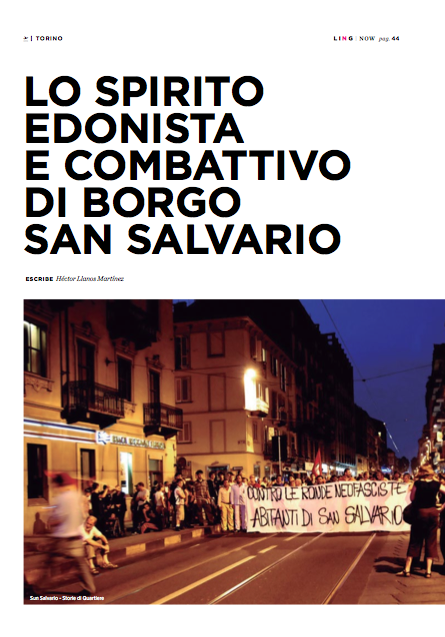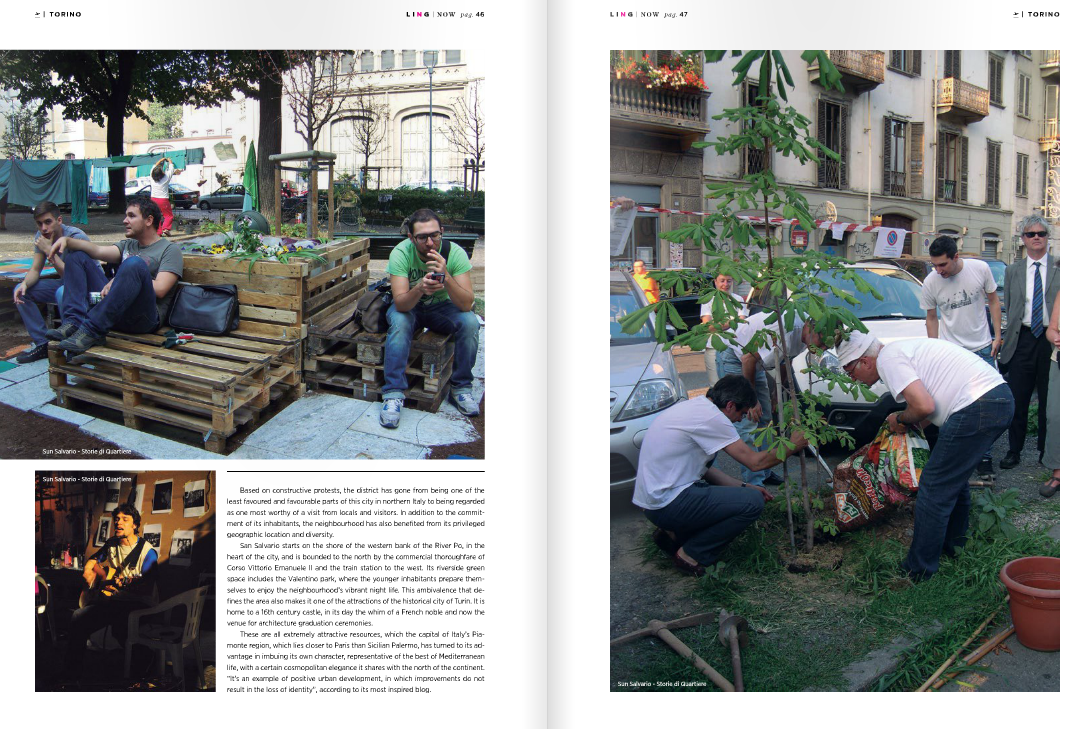La rivista Ling Magazine, rivista di bordo della compagnia aerea spagnola Vueling, ha dedicato un approfondimento sul quartiere di San Salvario a Torino. L’articolo del giornalista Héctor Llanos Martínez ha descritto San Salvario con un taglio particolare, ponendo l’accento sul carattere combattivo e sociale che in numerose occasioni ha mostrato il volto più vivo del quartiere.
Trovate l’articolo alle pagine 44-47 della numero di gennaio 205 di Ling Magazine, visionabile gratuitamnte a questo link: www.lingmagazine.es
Il giornalista della rivista Ling Magazine ha interpellato anche il nostro sito e abbiamo fornito alcune fotografie.
LO SPIRITO EDONISTA E COMBATTIVO DI SAN SALVARIO
Manifestazione: un termine ricorrente a Borgo San Salvario. Ogni volta che qualcosa è suscettibile di miglioramento, gli abitanti di questo pittoresco quartiere di Torino non esitano e invadono i viali principali per reclamare, con spirito più festivo che di protesta, tutto quanto è necessario per il bene comune.
Se considerano che la presenza dell’estrema destra sia più abituale di quanto desiderato, scendono in strada; se ritengono che non si stiano rispettando i diritti degli immigrati, lo ricordano a tutti con fiumi di cartelli. Gli stranieri sono una parte importante di questo luogo da decenni e per molti arricchiscono l’offerta culturale e gastronomica dei centri culturali e dei mercati rionali.
E quando la gente di Borgo San Salvario constata che le condizioni delle aree pubbliche del quartiere presentano di nuovo quel degrado vissuto durante tanti anni, approfitta del bel tempo per organizzare concentrazioni all’aperto.
Lo spirito edonista, come già commentato, è forte e spesso in questi atti rivendicativi non manca un momento dedicato all’aperitivo, quella consuetudine tutta italiana che consiste, dopo una giornata di lavoro, nel recarsi al bar e sorseggiare uno Spritz degustando le delizie di un ricco buffet, con alcuni degli stuzzichini tipici della gastronomia italiana. Lì accade tutto e l’opposto a tutto. San Salva
rio, you drink there, we live here: voi bevete a San Salvario, noi qui ci viviamo, questo è
il motto di Sun Salvario Views (www.sunsalvario.it), un blog con un chiaro intento: mostrare cosa offre il quartiere e al tempo stesso proteggerlo. Un quartiere dall’ambiente rilassato, al quale contribuisce anche l’architettura disinvolta di molte delle sue strade, con edifici che non superano i
cinque piani di altezza.
A base di proteste costruttive questa zona della città, un tempo degradata, è diventata una delle più interessanti di questa urbe dell’Italia settentrionale, e attualmente è considerata una delle zone che meritano di essere frequentate sia dalla gente del posto sia dai turisti.
Ma non solo l’impegno degli abitanti del quartiere ha agevolato questa condizione; i vicini del borgo hanno beneficiato anche della sua privilegiata posizione e della sua diversità.
Borgo San Salvario nasce lungo la riva occidentale del fiume Po, proprio al centro della città. Confina a nord con l’importante Corso Vittorio Emanuele II, arteria commerciale del capoluogo piemontese, e a ovest con la stazione ferroviaria. Nella zona verde del borgo, vicino al fiume, si trova il parco del Valentino, dove i più giovani si incontrano per poi lasciarsi andare alla vivace vita notturna del quartiere; e qui si trova anche il castello del Valentino, edificio che risale al XVI secolo, costruito per capriccio di una nobildonna francese, e che ora è sede della Facoltà di Ar- chitettura. È una zona dal carattere ambivalente che la rende uno dei richiami della storica città di Torino.
Tutte queste risorse hanno una forza attrattiva notevolissima e il capoluogo del Piemonte, quasi a metà strada tra Parigi e Palermo, ne approfitta, facendole diventare elementi che definiscono il suo carattere mediterraneo con quel tocco elegante e cosmopolita che condivide con il nord del continente. E come sostiene quello che è il suo blog più ispirato: “Ci troviamo davanti a un chiaro esempio di riqualifica positiva, dove le migliorie non permettono che si perda l’identità del posto”.
Héctor Llanos Martínez
THE EDONISTIC AND COMBATIVE SPIRIT OF SAN SALVARIO
“Manifestazione” is a recurring word in the daily life of San Salvario. Every time something is susceptible to improvement, the inhabitants of this picturesque district in Turin do not hesitate to come out onto its main streets and protest for the common good, in a spirit that is closer to a festival than a demonstration.
If they regard the presence of the far right as more common than they would like, they go out onto the streets; if they think the rights of immigrants are not being respected, they remind people of this with a barrage of placards. Immigrants have played an important role in the city for decades and, in the view of many people, have enriched its culture and food through their cultural centres and street markets.
This means that when the inhabitants of San Salvario find out that the conditions in their public spaces are once again approaching the poverty they suffered for so many years, they take advantage of the good weather to come together outdoors.
There is a strong hedonistic spirit and it is often the case that the demonstrations include an aperitif, true to the Italian tradition of going to the bar for a drink of Spritz after work, accompanied by a free buffet with some of the staples of their cuisine. “Here all sorts of things happen, and their opposites too”, notes La Repubblica di San Salvario, a Copyleft blog. The relaxed architecture of many of its streets, with buildings less than five floors high, helps to create this laid-back atmosphere.
Based on constructive protests, the district has gone from being one of the least favoured and favourable parts of this city in northern Italy to being regarded as one most worthy of a visit from locals and visitors. In addition to the commitment of its inhabitants, the neighbourhood has also benefited from its privileged geographic location and diversity.
San Salvario starts on the shore of the western bank of the River Po, in the heart of the city, and is bounded to the north by the commercial thoroughfare of Corso Vittorio Emanuele II and the train station to the west. Its riverside green space includes the Valentino park, where the younger inhabitants prepare them- selves to enjoy the neighbourhood’s vibrant night life. This ambivalence that defines the area also makes it one of the attractions of the historical city of Turin. It is home to a 16th century castle, in its day the whim of a French noble and now the venue for architecture graduation ceremonies.
These are all extremely attractive resources, which the capital of Italy’s Piemonte region, which lies closer to Paris than Sicilian Palermo, has turned to its advantage in imbuing its own character, representative of the best of Mediterranean life, with a certain cosmopolitan elegance it shares with the north of the continent. “It’s an example of positive urban development, in which improvements do not result in the loss of identity”, according to its most inspired blog.
Héctor Llanos Martínez

